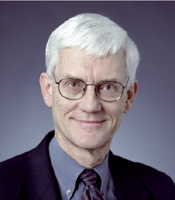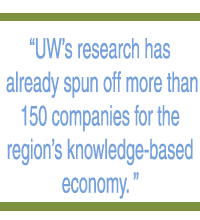Imagining the Future
March 2004
Thirty-five years ago, I arrived at the UW as an assistant professor of bioengineering-a field then in its infancy. I hadn't even heard of it until the summer before my senior year in college, when I was working at Boeing. It sounded so exciting that I reworked my undergraduate degree, entered one of the only three bioengineering graduate programs available, and then joined the young UW team (not yet even a department).
I could not have told you, then, exactly what bioengineering would become (any more than I could have imagined being president of this university). But if I'd had a crystal ball, I would have seen 21st century UW bioengineers working to fashion a beating human heart from engineered biomaterials. I would have seen diagnostic ultrasound, the product of UW research and a local company, saving thousands of lives around the world. I would have seen a UW department winning more NIH research funds than any other bioengineering program in the country. And I would not have been surprised. Even back in 1968, the future looked amazing.
It looks even more amazing today-and not just for bioengineering. From my perch as UW provost and now president, I've looked at the future through the eyes of many a visionary UW faculty member and inspired student. We still don't have a crystal ball, but I invite you to join me in some imagining.

President Lee Huntsman. Photo by Mary Levin.
We're on the brink of extraordinary breakthroughs in biomedical science and global health. Genomics, a field even newer than bioengineering and at least as interdisciplinary, will ultimately transform the practice of medicine-and the UW, I would argue, has the world's strongest genomics research team. Imagine preventive care for cancer or Alzheimer's disease that is tailored to each person's individual genomic profile. The UW is also part of a remarkable, intertwined community of biomedical researchers, NGOs and funders (think Gates Foundation) focused on the big challenges of health in developing countries. Imagine vaccines that will turn AIDS and malaria into scourges of the past. "Whatever direction the new endeavor of global health science takes," said Rick Klausner of the Gates Foundation recently, "it is pretty clear that Seattle will be at the epicenter of it."
What if we really understood the mysteries of human learning? What might that mean for the whole educational spectrum, from the first months of life to school and college classrooms to the retirement community? As in medicine, new computing and imaging technologies are opening up new windows on the brain. Our Institute for Learning and Brain Sciences is doing groundbreaking research on how infants learn language. UW experts on autism and dyslexia are finding out how learning goes wrong and how to intervene. Last summer, the Carnegie Corp. chose the UW College of Education, in partnership with the College of Arts and Sciences, to help reinvent teacher education-and, as part of that effort, to teach aspiring teachers how to use the new discoveries of learning science. Imagine a future third-grade classroom transformed by this blend of scientific and educational ferment.

I could go on and on. Our environmental science programs have a collective strength that is virtually unmatched anywhere. How might that translate into the future management of global climate change? Undergraduate education here has changed enormously in the last few years, with students much more involved in research, community learning, problem-solving teams and international experiences. Imagine what might happen when today's students bring this kind of intellectual engagement to their future communities and places of work. UW research has already spun off more than 150 companies for the region's knowledge-based economy. Imagine how the University's strength in biotechnology and photonics-to give only two examples-might help power a dynamic regional economy that expands opportunity for everyone.
None of this is inevitable. All of it presumes we will be able to solve some of the very real problems facing this University right now. But just as I believed in the future of bioengineering 35 years ago, I believe today in a future that will be shaped in manifold ways by the University of Washington. The promise of this place is too great to imagine anything less.

Lee Huntsman, Interim President
|
 THE UNIVERSITY OF WASHINGTON ALUMNI MAGAZINE
THE UNIVERSITY OF WASHINGTON ALUMNI MAGAZINE
 THE UNIVERSITY OF WASHINGTON ALUMNI MAGAZINE
THE UNIVERSITY OF WASHINGTON ALUMNI MAGAZINE